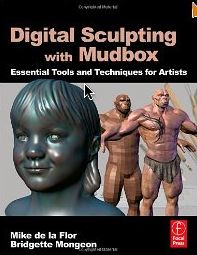Digital printing
Speaking at Penn State
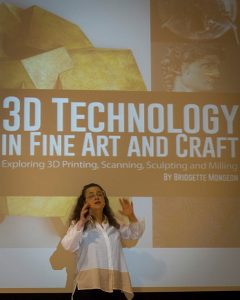
This past week, Penn State University, The Behrend College invited me to Erie PA to speak on my new book, “3D Technology in Fine Art and Craft: Exploring 3D Printing, Scanning, Sculpting and Milling” I also shared about my new project of a monumental sculpture of Alice in Wonderland’s Mad Hatter Tea Party. The processes I am using on the Alice sculpture are the same processes I cover in my book.
My host was Heather Cole from Penn State’s new interdisciplinary degree major- Digital Media, Arts, and Technology. My visit was supported by the Endowment Fund. Penn States interdisciplinary degree combines the broad perspective of the liberal arts with technical skill. The Penn State website describes the Digital Media Arts, and Technology major. The students study technology history and theory at the same time they are learning to use the newest programming languages, digital tools, and computer systems. I’m thrilled that this program is looking at using my book as a textbook for Digital Media, Arts, and Technology major.
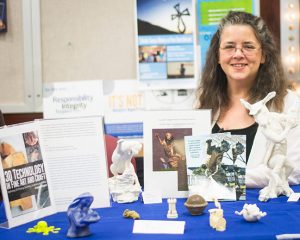
There were both students from the campus and others from art groups in the area that attended. Many students from the engineering department were also in attendance, in fact, when I asked how many students in the arts that there were in the audience, 1/3 of the audience raised their hands. There were, in fact, more people interested in engineering than those working in the arts. That is no surprise to me. The book and the lecture are very interdisciplinary. I cover such things as 3D printing, and computer numerically controlled machining, digital presentation, and the workflow of a project from digital concept to fabrication. It is a good lecture for both those in the art, those studying engineering, architecture, design, industrial design and more.
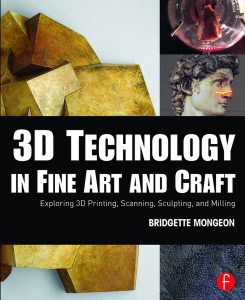
Along with the book signing, I had samples of the 3D prints created by 3D RP of the digital design that I used to create the 15-foot bronze sculpture of the Grambling Tiger. 3DRP also created a 3D print of the March Hare. He is a bit stained with clay as we have been looking at him constantly while we are making the 8-foot tall sculpture. Other examples that I brought of 3D printing were some 3d printed bronze by exone. Some 3d printed wax jewelry, articulated pieces and 3d prints that are examples of the great detail you can get from the different types of 3d printing and 3d printing of objects inside of other objects.
Of course, there were plenty of Alice in Wonderland pieces that I was showing and I encouraged attendees to follow along with this newest project on the Finding Alice Facebook Page. And I always try to have other materials that attendees can take home like a list of all of the contact information such as:
- A description of the website created for the book at digitalsculpting.net that has further information will hold tutorials and has podcasts about art and technology.
- There is also a Facebook page for the book. These are created for others to share their work. It is a place where others and I can address questions that people have about the technology and processes, I also encourage vendors to come and share their processes and expertise.
- Brochures from my vendors like Shidoni foundry, my ( CNC) Computer numerically controlled milling companies such Synappsys Digital Services and Across the Board Creations. The video of milling by Synappsys was a big hit in the presentation, and you can see it for yourself on you tube. (Fast forward to about the two minute mark.)
The Digital Media, Arts, and Technology Department brought their MakerBot fused deposition modeling (FDM) 3d printer and had it running. Many thanks to Heather’s Bread and Circus Club at Penn State who monitored the table while I was in giving the lecture.
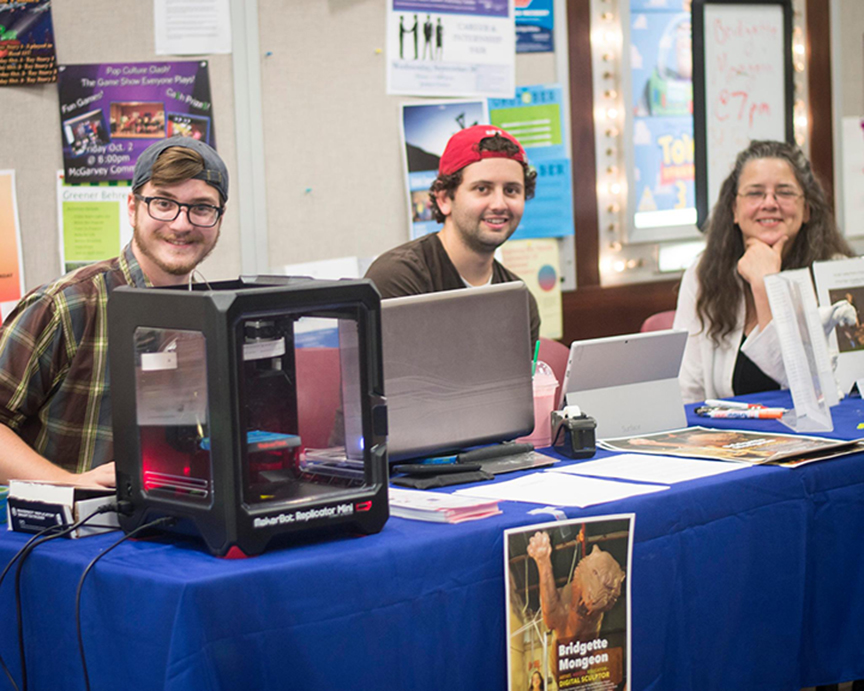
My daughter created a wonderful banner for my new speaking engagements, and we had that outside the auditorium.
The attendance was great, the hospitality and the quaint campus a pleasure to visit. The next day on my way back to Buffalo for my next engagement, I took a short jaunt to Presque Isle state Park. It was a lovely little side trip. I drove through the park, looked at the wildlife and learned about the Battle of Lake Erie, from which came the saying “We have met the enemy, and they are ours.” The Penn State Library with their intriguing exhibit complete with a replica of the ship was my first introduction to the-the battle of Erie and Master Commandant Oliver Hazard Perry.
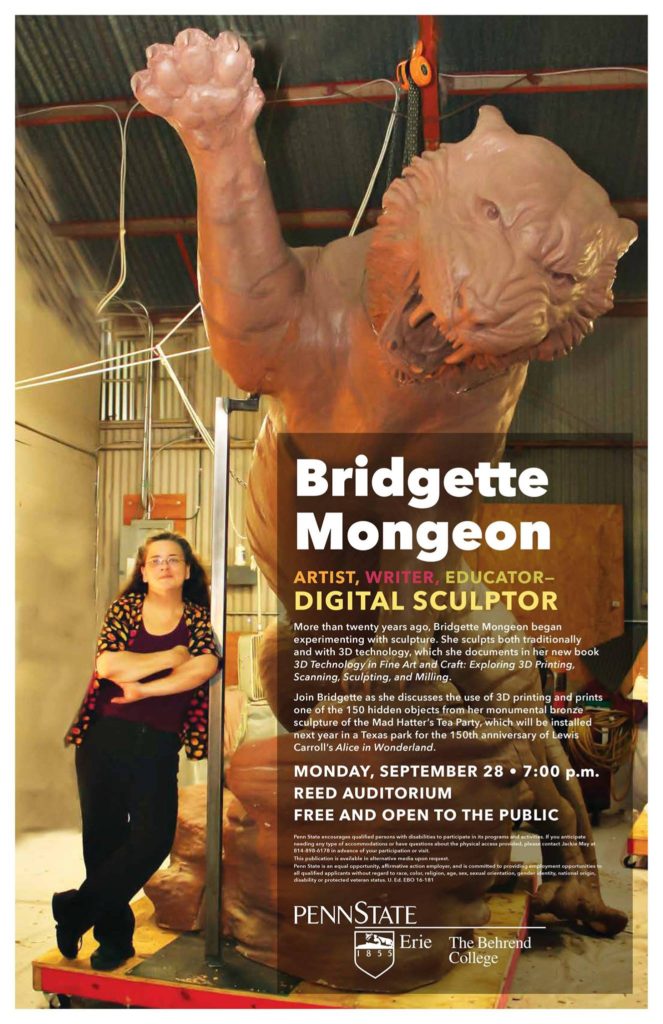
Thanks, Penn State University, The Behrend College. I look forward to helping your students through the various resources mentioned above. Who knows, maybe their work will be in the next edition of 3D Technology in Fine Art and Craft: Exploring 3D Printing, Scanning, Sculpting and Milling.
If you are interested in having me come to your University or group, please contact me through my fine art website. I am traveling around quite a bit and would love to come and talk.
Bridgette’s presentation excellently conveyed the practical aspect of 3D modeling. Being able to see the models she created come to life in a real physical project was very inspiring.
Will Gerould- Student
I was thrilled about the broad turn out of students and community members that were in attendance. Bridgette did a wonderful job of covering the subject from an interdisciplinary approach and I think many came out with a better understanding and appreciation of the work involved.
Heather Cole- Instructor Digital Media, Arts, and Technology
Heather, thanks for bringing Bridgette, it was a great glimpse into the life of a professional artist and some amazing technology.
Dr. Chris Coultson- Professor School of Engineering.
Which Medium Do You Think Is More Flexible, Digital or Analog Clay? An Austrian Student Interview Cont.
2. Which medium do you think is more flexible, digital or analog clay?
I have described a bit of this in a previous post, however, in defense of digital sculpting, the tools that are available intrigues me. For example, sculpting symmetrically, though no person is symmetrical, I can change that at the end. But in digital I don’t have to sculpt two eyes, or two ears, etc. When I can shorten the amount of time of getting the shape and instead focus on the detail the technical process allows me more time for creativity.
By far the most hindering part of the digital process is the output. There are still a few factors that interfere with my process in this area. One is cost, and the other is the medium, also the build envelope or size. I’m finishing a bust in traditional clay right now, but I would much rather have created it digitally. However, my resources for out put would have been milling in foam, a good armature for larger pieces, but I would have still had to do the details again, and I do not like the stiff look that a piece of foam covered in clay has.

I could mill it out in stone; I must say I anxious to have a project where I can explore this more. All my life I have sculpted in clay, concrete, bronze or pourable mediums. Now with digital milling in stone I can extend my tool set to “stone carver”. With the Digital Stone project, I can create artwork in this medium, as well. This excites me to no end. When I think of the possibilities I also consider the many projects I have given up over the years not having this skill set.
I also love the idea of doing more architectural sculpting work using the digital tools. Creating a finial and being to enlarge it 20% or anything in steps of enlargement is huge. There is no price that can be put on that.
However, digital printing in any other medium is not a viable option, either because of the build envelope or the cost.
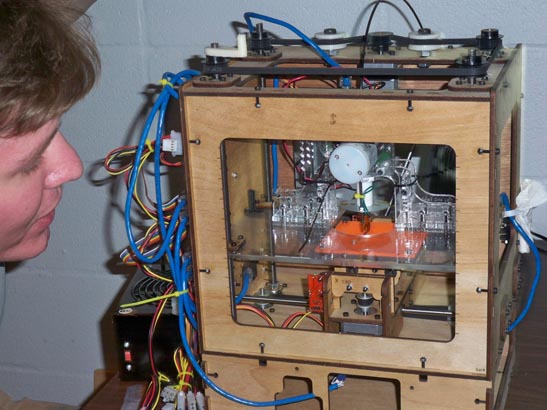
Im intrigued with the research at Solheim Additive Manufacturing Laboratory in the Mechanical Engineering Department on the University of Washington campus. If only I could create in the computer and then digitally print out my form in clay in my own studio, like they are doing at this lab. I think this would be a viable resource for me. I know that the open source “free” 3d printers like Rep Rap or maker bot have some attachments to digitally print in clay, and I’m waiting to see how these evolve.
I think another resources is materialize by .mGX for going directly to bronze, though very expensive. I have visions of using them on an intricate piece similar to Alfred Gilbert’s Virgin Mary or St. Michael. Pieces that would be a nightmare to recreate in a triditional bronze process but could easily be done with .MGX.
The very near future will drastically change the way I work. As many of the patents have ended on 3D printing, I believe you will begin to see a change in the cost factor and availability of home 3D printers. I still may be limited by the build size, unless, of course, I can figure out how to change a machine to accommodate my needs. I’m not sure I am that mechanically savvy.
As I write this, I find an aching. To go from screen to finished project without touching it leaves a hole inside of me. I am afraid I will not be able to “feel” the emotion of the piece unless I touch it. Oh, this is a strange thought.
Though looking at the quick sketches in my Mudbox video I can feel the emotion without touch. Will it feel the same digitally printed?
Remember, I am still a traditional artist. I get paid for a tangible piece of art. I need to get the sculptures out of the computer. I must base my choices on that final output.
This is an interview of 10 questions by Mathias Herbster of FH Vorarlberg University in Austria directed to Sculptor Bridgette Mongeon about the comparison of digital and traditional sculpture.
_____________________________________________________________________________

-Sculptor, Writer and Speaker
Bridgette Mongeon is a sculptor, writer, illustrator and educator as well as a public speaker.
Her blog can be found at https://creativesculpture.com.
She is also the owner and creator of the God’s Word Collectible Sculpture series
Follow the artists on twitter twitter.com/Sculptorwriter twitter.com/creategodsword
Facebook http://www.facebook.com/bridgette.mongeon
Listen to The Creative Christian Podcast or the Inspiration/Generation Podcast Click on Podcast Host Bios for a list of all podcasts.
Listen to the Art and Technology Podcast
Creating An Author’s Page At Amazon For The Mudbox Book
For those of you who don’t know, I coauthored a book with my husband called Digital Sculpting in Mudbox: Essential Tools and Techniques. Most software books can become dated, but this book talks about things that others do not. Let me tell you about the two chapters that I am proud of. I should be proud, I wrote them and labored over them. One chapter brings a person through the entire process of sculpting a portrait digitally. Yes, I have taken my traditional process and expressed it digitally. So this book will help with that. You can use it if you are using Mudbox or the competition Zbrush. It will also help if you are a traditional sculptor. The other chapter talks about digital printing, milling and scanning. This is huge and I would love to do an entire book on this subject, just in case there should be a publisher that is interested. For those of you who don’t know, you can now print things in 3d. Yes, you can create objects in the computer and print them. Kind of like the Star trek replicator. The difficulty is, that not many artist know the processes that are available for this sort of thing. That is what this chapter is about. Breaking it down into bite sized pieces and also offering the reader a list of resources. In my opinion, this information is worth purchasing the book. You just can’t find it compiled anywhere else.
If you want to see my authors page just click on this Amazon link to the book and then on my name.
We have also put together a website and forums for this book. It is located at digitalsculpting.net Be sure to also check out the podcasts on art and technology at the website.
A New Book Proposal
I just sent a new book proposal to the publisher. Art and Technology- Exploration of resources and advancements in digital sculpting, printing, milling and scanning. I know, I am just able to breath after fishing Digital Sculpting with Mudbox Essential Tools and Techniques for Artists.
I’m also knee deep in the Art and Technology podcast and the new website at http://www.digitalsculpting.net
The new book project is terribly exciting. It will feature a great deal of the research I am doing on this subject for my graduate studies. As I stated in the book proposal.
Art and Technology- Exploration of resources and advancements in digital sculpting, printing, milling and scanning. Finally, a resource guide for understanding and accessing tools in digital printing, milling and scanning. This technology is not just for manufacturing or engineering but can be embraced by designers, traditional and graphic artists who want to utilize these technologies in their creativity and in their workflow. This resource breaks down the process and possibilities for artists.
This book helps to inspire, as artists can see what others have created and push their imagination utilizing new technology. The technology can help save artists time and help artists create in ways that have never been conceivable until this time. Inspiration- strengthens your creativity and enlarges your artistic tool set.
I should know something in two – three weeks.
I Am So Excited. I Just Scored Two More Interviews For The Art And Technology Podcast!
Each person I ask is because I am very interested in what they are doing, researching, or their place in this field. Do you want to know the two? Yes, more global interviews courtesy of Skype!
Adrian Bowyer- Bath
From Mr Bowyers website. “I am a senior lecturer in the Department of Mechanical Engineering at the University of Bath working in the Biomimetics Research Group on the RepRap Project and the Bioaffinity Applications Laboratory.” I thrilled about this interview. I have posted some wonderful videos about this man and what he has been doing. I love the idea of the RepRap. For those of you who don’t know what that is, a Rep Rap is a printer that prints objects in 3d, but no one that you are going to spend hundreds of thousands of dollars on. It is an open source project. You could build one of these for your own office/studio. I want one! Oh yeah, Did I mention that the RepRap can print itself?
Andrew Silke- Sydney, Australia
Mr Silke’s webiste the Guerrilla Cg Project states, “Andrew Silke is a professional animator and founder of The GuerrillaCG Project. With over 8 years experience he has worked on major feature films such as Happy Feet, Scooby Doo, and James Cameron’s new movie Avatar as well as creating award winning short films like as ‘Cane-Toad’ (with David Clayton).”
“The GuerrillaCG Project is a free non for profit organisation that hopes to make it easier to learn high-end computer graphics. We are building a team of volunteers to create videos, that describe in an easy and understandable manner, the fundamental concepts of computer graphics. ” I love this site and Mr. Silke’s dedication to education. If you are new to digital technology or a traditional sculptor needing to begin to know about the process of digital technology this is a great place to start.
Subdivision Topology: Artifacts from The Guerrilla CG Project on Vimeo.
Can I Really Digitally Print In Metal?
This is an excellent video that discusses Powder Metallurgy.
I know it seems like it is something that is not affordable not doable for the average person. But shapeways is making this connection to the common artist, the every day guy. Check out this video
And their prices are extremely affordable. http://www.shapeways.com/
3D Camp Houston Was A Success. Next Year Bigger And Better.
It was last Wednesday that my husband invited me to the 3D modelers and animators meetup. I was interested in the presentation on Zbrush by Johannes Huber. It was there that I met David Morris. David told me about a project he had been working on for just 8 weeks. It was a 3D camp, planned for this past weekend. He envisioned a place where people could get together and talk about 3D. My husband Mike delaflor and I jumped on board.

David was doing exactly what I wanted to do. I had actually been thinking about this for a year. I was going to do it this fall, but instead decided to perhaps make it a part of my graduate practicum. I had already talked to Next Engine, who have some wonderful affordable desk top scanners. Ex One who you have seen in previous posts. I have been contacting them about their direct metal printing and last month I went to see there printing sandcasting Molds. Ex One said when I was ready to get this going they would try to get Shapeways on board. For those of you who don’t know about Shapeways they are affordable service bureau for 3d digital printing, and they too are now offering digital printing in metal!
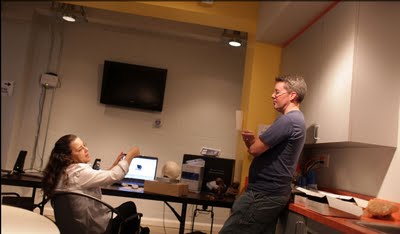
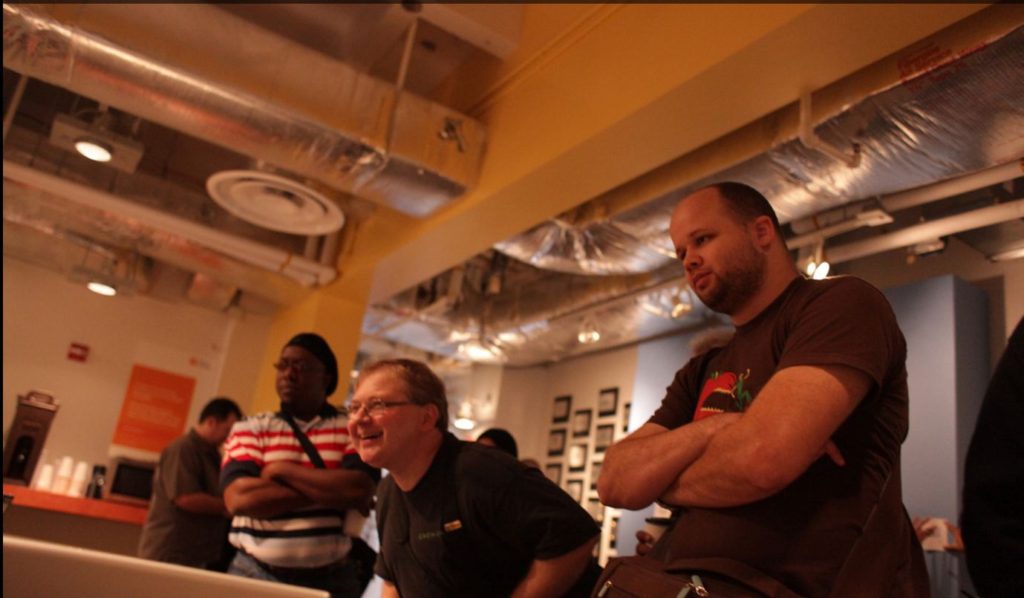
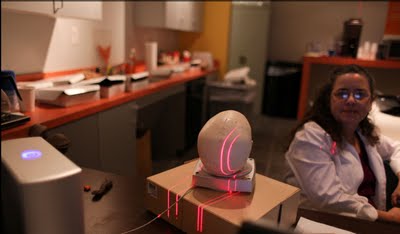

My goal was to get some vendors there and also offer some informative lectures on different processes of 3D. Well David did just that with 3D camp. I’m so excited and totally impressed with this young man. I think you will see this 3D camp grow in the up and coming years. I’m looking forward to presenting next year, and hopefully get the above vendors to demonstrate.
This year I demonstrated the 3D scanner, though I must say it was a crowded area and hard to get a good scan with so many people bumping the table. Still I get was able to sing the praises of this scanner that we are reviewing and using in our up and coming book, Digital Sculpting with Mudbox: Essential Tools and Techniques For Artists.
I also had this video playing and my article that I wrote for Sculpture Review on digital printing and milling where I talked about the incredible advances of Synappsys digital printing and their Data Direct to Mold process that is being used on The American.
My vantage point of 3D is coming from a traditional studio and using it to create traditional art. I suppose my focus then is a bit different than the traditional 3D artist. My graduate studies at Goddard- A Master of Fine Arts In Interdisciplinary Arts is based upon bridging the gap between the traditional and the digital studio. That is my interest. Though I have to admit, programs like Mudbox and Z brush are very intriguing and I expect I will be using them much more in the future. Oh no am I converting? Still I like the clay under my nails and my heart longs for dirty hands.
I encourage others to get involved with 3D camp next year, and plan on attending. I’m expecting it will double if not triple in size with a year of planning, some more backers, and some good promotion. If you would like to be a sponsore, If you are interested in presenting or are a vendor that would like to show at 3D camp next year please feel free to contact me or David.
Great job David!
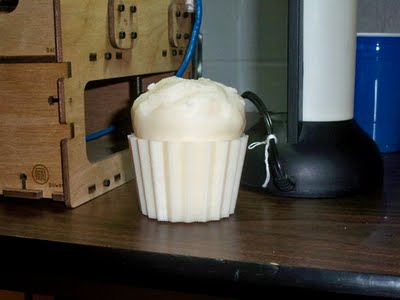
Some of my favorite things there revolve around output. This is a home made cnc router machine. To check it out further go to http://buildyourcnc.com/default.aspx
Many seemed to be interested in what a fine artist had to say in a 3D camp.
Another of my favorite had to again deal with output. It is the homemade 3D printer. This one is called the cupcake, and I must show that it can print a cupcake. I believe the cupcake costs about 700. to put together. There is another homemade one that I want to investigate but it costs approximately 3,000. Kind of steep to do for a hobby or to check out, but this other can print ceramic and chocolate, something worth investigating. I plan on reviewing all of these home made machines in an upcoming article.
3d Printing In Ceramic!
I’m looking forward to working with Solheim Rapid Prototyping/ Rapid Manufacturing Lab at the University of Washington’s Mechanical Engineering Department, collaborating and certainly want to add their process to the new book that I intend to write, my articles and a lecture. I love seeing video and am certainly glad that this was created. I will be trying to contact them on their process and new technology and will be sure to let you know what comes from that.

